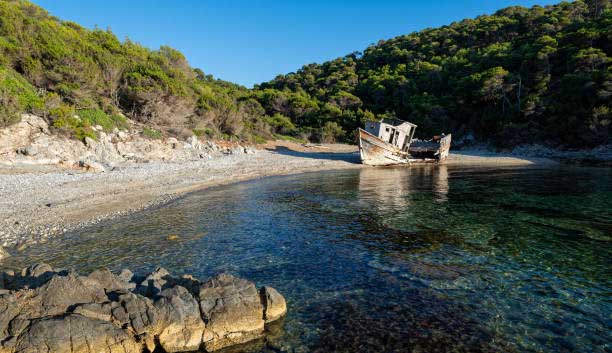Where to swimm and dive in Skiathos
The coastline of Skyros is peppered with lovely sandy beaches, quiet secluded coves, sea caves and remote rocky inlets. You can join the mid-summer holiday hordes at the main beach north of Skyros Town or hire a boat or scooter to isolated swimming spots far from the madding crowds.
Families and watersports enthusiasts congregate at the 800-metre stretch of sandy beach which connects the twin resorts of Magazia and Molos, a short distance north along the coast from the capital. Magazia is about 15 minutes walk from town along the path and steps leading from Eternal Poetry Square.
The resort, at the southern end of the main beach, is a pretty place with narrow, winding alleyways. With increasing development along this stretch of coastal road it’s almost impossible to separate Magazia from the resort of Molos at the beach’s northern end. If you’re into beach volleyball, watersports and plenty of company this is the place for you.
The beach is served by some excellent tavernas including Tou Thoma Magazi on the beach at Molos where seafood dishes are prepared from the freshest fish caught by the owner’s father.
If you tire of the high season crowds and fancy a spot of nude sunbathing and skinny dipping head for uncrowded Tou Papa to Homa, an unofficial nudist beach directly below the kastro.
Keen hikers can tackle the lovely walk from Skyros Town through the island’s wooded interior to the west coast village of Atsitsa. The walk will take you about three to four hours (the track’s unsafe for scooters) but you can motivate yourself with the thought of a swim at Atsitsa’s pretty pine-fringed pebble beach and a meal at the local fish taverna, O Andonis.
A short walk north of Atsitsa there are the small, sandy and uncrowded beaches of Kalogrias and Panagia. If you have your own transport there’s a superb sandy beach at Palamiri at the northern end of the island near the airport.
South down the coast from Atsitsa there’s Agios Fokas with three lovely white pebble beaches and a top class small taverna serving fresh fish from the owner’s boat and home-made cheese.
From the main port of Linaria you can take a boat trip to secluded beaches around the island or visit the grottoes of Pendekali and Gerania on the east coast. Caiques also take visitors to the islet of Sarakino, off the southern tip of Skyros, which was once one of the biggest pirate hideouts in the Aegean. The islet is home to some of the extremely rare indigenous Skyrian ponies which have been bred here since ancient times.
Kalamitsa, south east along the coast from the port, has a reasonable beach and is a popular spot for fishing and windsurfing.
The south coast of the island has some scenic unspoilt beaches which can only be reached by boat or via rough, dirt tracks.
Molos beach Skyros
The sprawling tourist development below Chora and behind Magazia beach now blends into neighbouring Molos village, about four kilometres north from the capital.
Hotels and apartment blocks lie behind an attractive, long and sandy beach that snakes out north to a headland and a small, picturesque harbour and stone breakwater.
An old mill, now turned into a taverna, is a reminder of times past when Molos was less developed as a tourist destination. Lobster is the local specialty and worth a try.
There are a good many fish tavernas in Molos as well as bars and cafes, a bakery and a mini-market.
Further north, past the harbour and around the headland, is Grysmata beach, sheltered by a strip of offshore rock and which has a few tavernas and some accommodation, although there are no facilities here.
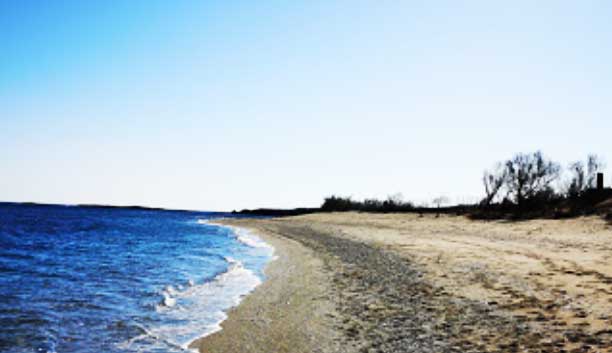
Magazia beach Skyros
A 10-minute walk down the hill and stairway from Chora, leads visitors past the island’s official campsite and onto the fine dark sands of Magazia, to the south of Molos.
The a long, sweeping beach is named after the gunpowder magazines that were stored here in Venetian times.
Fast being developed, but still quiet and relaxed, Magazia has plenty of beach facilities including watersports and beachside tavernas.
Long and sandy it blends in with neighbouring Molos and rarely gets crowded even in the high summer season.
Sunbeds are laid out on the most popular stretches and the water is quite shallow. A trio of rock breakwaters have been dumped offshore to the south.
At the northern end of the beach the rock has been carved and quarried into bizarre shapes, with a church and cave-like houses hewn from the stone.
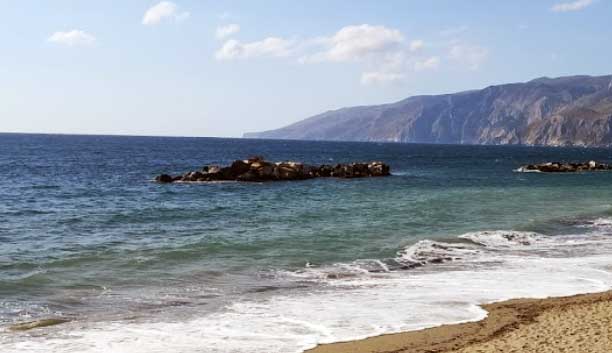
Papa Ta Chomata beach
The road south beyond Magazia leads to Papa Ta Chomata beach, sometimes referred to as Papa Ta Houma. The name translates roughly as ‘land of the priest’ but visitors may find little of the cloth here as this is the island’s unofficial nudist beach.
The sands at Papa Ta Chomata are fine and the water is clean, although it can be a difficult descent down a narrow cliff path to the beach. Beaches further south of here are disappointingly drab until you get to Aspouss which is a pleasant spot with a couple of nice beach tavernas.
Nearby Basales is an even less developed alternative to Papa Ta Chomata but visitors must beware of the sewage that can arrive with the tide when wind is in the wrong direction (north or north-east). This is not the cleanest beach on the island as sewage from the Chora ends up near here.
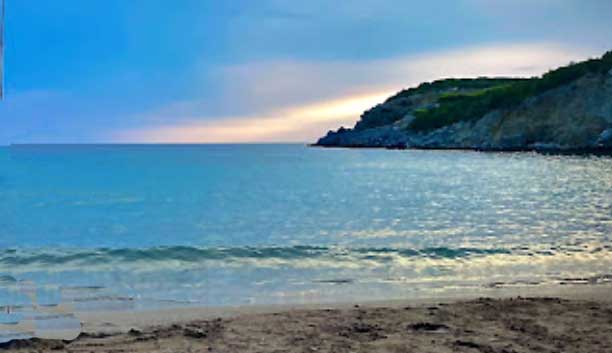
Ormos Achillis beach
Further south still is the beach at Ormos Achillis. Set in a deep bay this once boasted a pleasant, if remote, beach until it was earmarked by developers for a new yacht marina.
Part of a government drive to attract yachting tourism away from Turkey the marina project failed and, apart from a few fishing boats, the place is deserted.
South of the bay at Ormos Achillis the coast becomes very rocky and virtually inaccessible except for the tiny islet of Sarakiniko which has a tiny beach of white sand and shingle called Nisi tou Despoti, or sometimes Glyfada.
A boat is the only way to reach the beach which sits on almost the most southern point of Skyros and has no facilities.
This heavily indented stretch of coast is a popular target boat trips, not only to see the grave of the English poet Rupert Brooke at nearby Tris Boukes, but to explore the spectacular caves and inlets on the south-east coast.
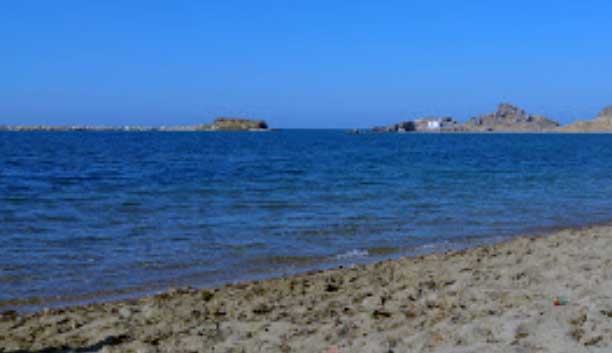
West coast beaches of Skyros
The west coast of Skyros is where island ferries dock at the main port of Linaria. A number of attractive beaches line the heavily indented shore. Many lie at the head of sheltered inlets and are surrounded by thick forests of pine.
Kalamitsa beach
Kalamitsa lies to the south of Linaria, just over the headland, and lays claim as one of the best beaches in the south-west – which is not saying much as it is just about the only one.
Not much more than a long swathe of shingle, the sand does peep through the stones at the northern end which is fronted by tavernas, a few villas and a windsurfing club.
Nearby is a well-preserved stone sarcophagus and an upright Doric column. To the south Kalamitsa blends into the long, white shingle beach of Kolimbades which has some good swimming.
There are coves with shingle beaches further south, although none have any facilities and most can only be reached by boat.
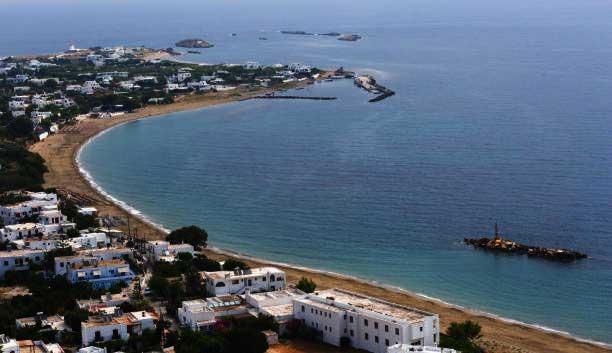
Aheronas beach
The road north out of Linaria heads into the hills and a barren landscape of low scrub. The road forks right to Chora and left around the bay to Aheronas, also spelt Acheronas or Acherounes.
The pleasant long, sandy beach is at the head of a well protected bay with clear shallow water that makes it a good choice for families with children.
Two tavernas offer the basics and a cafe serves ice cream and drinks. As Aheronas beach is only a 10-minute walk from Linaria it is a popular choice for those staying in Linaria, although the prettier beach of Agios Pefkos is only just over the headland.
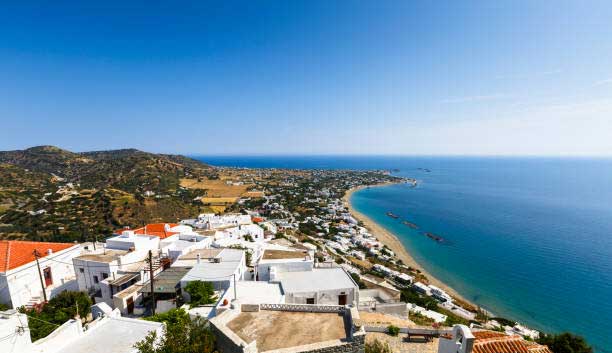
Agios Pefkos beach
This is the beach many visitors head for on the west coast of Skyros. Agios Petros lies over the headland from Aheronas at the head of a deep bay, about 11 kilometres west of Chora.
Pine trees tumble down to the sand and shingle shoreline at the wide and attractive bay. Rocky outctops appear at both ends and a long line of trees backs the beach to the south. A couple of cantinas open here in the summer season.
Some parking is available on a patch of land off the main road that skirts the south of the beach and it is a short walk down a dirt track to reach the shore.
Once the site of a small but productive marble quarry, the small harbour that lies to the south of Agios Pefkos is where the Syrian marble used to be shipped out.
Also nearby is the charming chapel of Agios Panteleimonas, which enjoys some spectacular panoramic views over the coast of Skyros.
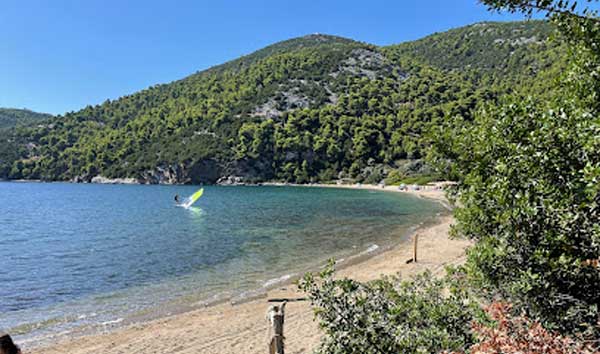
Agios Fokas beach
North from Agios Pefkos and down a steep bank is the smaller, but even more attractive bay of Agios Fokas. Despite being prettier than its neighbour fewer make it down the rough track that snakes down from the road above.
Once cloaked in pine forest, a fire in 2008 denuded much of the area but this remains a picturesque spot in a beautiful bay and the reward for going the extra few miles is well worth it with a beach of sand and white pebble and the small chapel at the end of the beach.
Agios Fokas has a basic, but excellent, taverna that opens in the high summer. Both Agios Fokas and neighbouring Agios Pefkos have recently been discovered by villa companies and their days as peaceful havens may well be numbered.
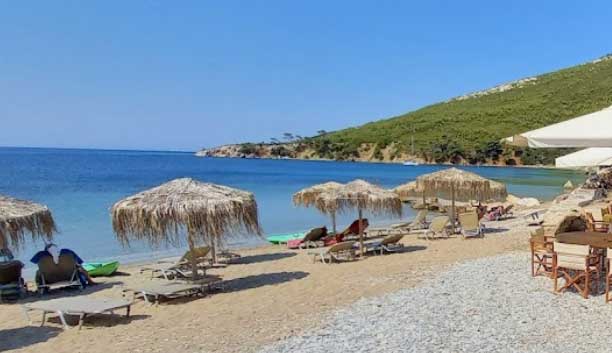
North coast beaches of Skyros
The far north of Skyros has the best of the secluded beaches, but they are not always easy to find and few of them have any facilities. This coast also takes the winds and heavy seas that batter the cliffs over the winter as well as the northern ‘meltemi’ that blows through July and August
Atsitsa beach
Set in a peaceful wooded bay Atsitsa lies on the north-west coast about 19 kilometres from Chora and is mostly rock and stones with a couple of ramshackle wooden quays where boats can tie up.
Atsitsa is home to a British-run holiday meditation centre where signs deter passers-by from straying near. The karma here is very much up-market exclusive.
Named after the offshore islet, Atsista is set in densely wooded coves and has some iron mine installations dating from the 19th century. Pine trees plunge down to a shoreline that is rocky enough to make swimming difficult but there is a good fish taverna here.
To the north, at Markesi, is the chapel of Theotokos erected on the site of a former temple to Poseidon where ancient tomb carvings have been found.
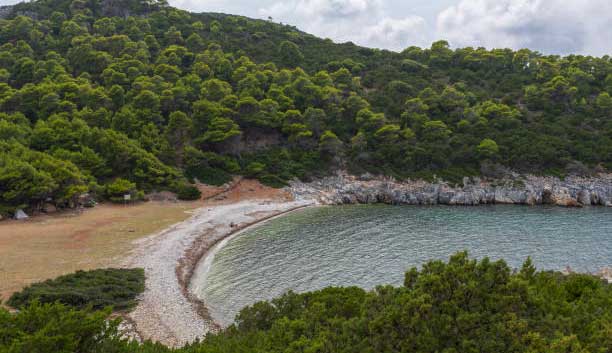
Agios Petros beach
Just north of Atsitsa are a couple of small and rather nondescript beaches of sharp sand and shingle at Kalogrias and at Krya Panagia, the latter of which has a tiny chapel and a summer taverna.
The best of the beaches in this area is Agios Petros, a pale sand beach with a few pebbles backed by magnificent dunes
Access to Agios Petros is down a track through the dense pine woods that starts near the airport.
Like the others beaches in the area there are few facilities at Agios Petros. A beach cantina sometimes opens in the summer when the small beach can get quite busy.
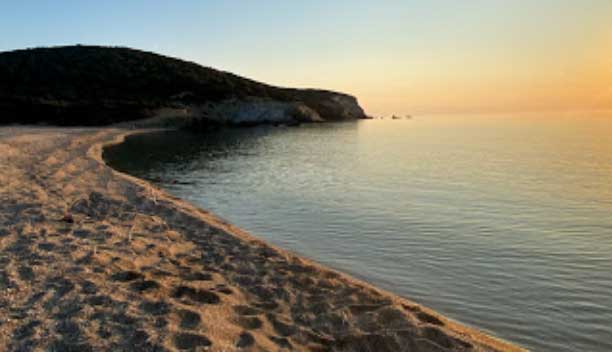
Markesi beach
There are several sand and pebble beaches along the stretch of coastline that makes up the northern tip of Skyros. None are well known and all are sparsely populated.
Two that are most worth a visit are Markesi and Theotokos, although you may have to contend with the drone of jet aircraft taking off from the nearby military air base.
Although neither has any facilities both have good shallow water, a little sand and shingle and rocky outcrops on either side.
There are some ancient engraved tombs near Markesi for those interested in archaeology near the chapel of Agios Theotokos.
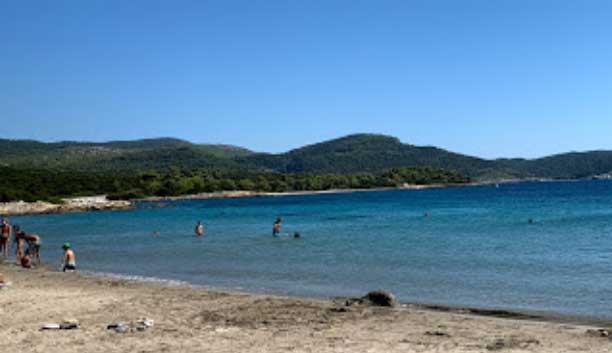
Palamari beach
Palamari is most noted for the interesting, if rather neglected, site of a Bronze Age settlement which still shows the layout and pattern of the original streets and houses.
It was first built around 3,000 BC and flourished for a millennium. The total area covers about five acres, although the eastern part is now under the sea.
The main reason for the ancient city’s growth was the metals that were once mined in the Palamari area. Below the archaeological site is a very pleasant sand beach but care must be taken not to wander too near the military base which is a restricted area.
